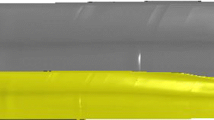Abstract
The application of multi-hull ship or trimaran vessel as a mode of transports in both river and sea environments have grown rapidly in recent years. Trimaran vessels are currently of interest for many new high speed ship projects due to the high levels of hydrodynamic efficiency that can be achieved, compared to the mono-hull and catamaran hull forms. The purpose of this study is to identify the possible effects of using an unsymmetrical trimaran ship model with configuration (S/L) 0.1–0.3 and R/L=0.1–0.2. Unsymmetrical trimaran ship model with main dimensions: L=2000mm, B=200 mm and T=45 mm. Experimental methods (towing tank) were performed in the study using speed variations at Froude number 0.1–0.6. The ship model was pulled by an electric motor whose speed could be varied and adjusted. The ship model resistance was measured precisely by using a load cell transducer. The comparison of ship resistance for each configuration with mono-hull was shown on the graph as a function of the total resistance coefficient and Froude number. The test results found that the effective drag reduction could be achieved up to 17% at Fr=0.35 with configuration S/L=0.1.
Similar content being viewed by others
References
Bertram V (2000). Practical ship hydrodynamics. Butterworth-Heinemann, Linacre House, Jordan Hill, Oxford, 74.
Boote D, Colaianni T, Pino E (2004). Seakeeping analysis of a trimaran fast ferry. 4th Int. Conf. High-Performance Marine Vehicle (HIPER), Rome, 304–316.
Degiuli N, Werner A, Zotti I (2005). An experimental investigation into the resistance components of Trimaran configurations. FAST’2005, Saint-Petersburg, Russia, 1–8
Dubrovsky V, Lyakhovitsky A (2001). Mullty hull ships. Backbone Publishing, Paramus, 495.
Fach K (2004). Classification aspects of HSC multihulls. 4th Int. Conf. High-Performance Marine Vehicle (HIPER), Rome, 317–322.
Hafez K, El-Kot AR (2011). Comparative analysis of the separation variation influence on the hydrodynamic performance of a high speed trimaran. Journal of Marine Science and Application, 10(4), 377–393
Hafez K, El-Kot AR (2012). Comparative investigation of the stagger variation influence on the hydrodynamic interference of high speed trimaran. Alexandria Engineering Journal, 51(3), 153–169.
Insel M, Molland AF (1992). An investigation into the resistance components of high speed displacement catamarans. Trans RINA, 134, 1–20.
Javanmardi EJ, Seif HS (2008). Hydrodynamic analysis of trimaran vessels. Polish Maritime Research, 15(1), 11–18.
Lindstrom J, Sirvio J, Yli-Rantala A (1995). Superslender monohull with outriggers. FAST 1995 Conf., Lubeck-Travemunde, Germany, 295–308.
Mynard T, Sahoo PK, Mikkelsen J, McGreer D (2008). Numerical and experimental study of wave resistance for trimaran hull forms. The 6th International Conference on High-Performance Marine Vehicles, Naples, Italy, 117–127.
Seif MS, Amini E (2004). Performance comparison between planning monohull and catamaran at high Froude numbers. Iranian Journal of Science & Technology, Transaction B, 28(B4), 435–441.
Smith RP, Jones JB (2001). Design, construction and trials of the trident trimaran test craft. Jahrbuch Schiffbautechnische Gesellschaft, Berlin, 355–362.
Xu H, Zou Z (2001). Numerical prediction of wave-making resistance of a trimaran. Proc. 2nd Int. Workshop on Ship Hydrodynamics (IWSH’01), Wuhan, China, 105–109.
Wang Z, Lu X (2011). Numerical simulation of wave resistance of trimarans by nonlinear wave making theory with sinking and trim being taken into account. Journal of Hydrodynamics, 23(2), 224–233.
Xu Min, Zhang Shilian (2011). A numerical study on side hull optimization for trimaran. Journal of Hydrodynamics, 23(2), 265–272.
Zhang Baoji (2009). The optimixation of the hull form with the minimum wave making resistance based on Rankine source method. Journal of Hydrodynamics, 21(2), 277–284.
Author information
Authors and Affiliations
Corresponding author
Additional information
Foundation item: This research work has been supported by the Directorate for Research and Community Service, University of Indonesia (RUUI Utama 2012), Jakarta, Indonesia.
Yanuar received his B.S. degree in Naval Architecture from University of Indonesia, Indonesia, in 1986. He then received his Master of Eng. and Doctor of Eng. in Mechanical Engineering from University of Tokyo Metropolitan, Japan, in 1995 and 1998, respectively. Professor at Mechanical Engineering, University of Indonesia in Jakarta, Indonesia. His research project is about drag reduction in internal flow or external flow.
Gunawan received his B.S. degree in Naval Architecture from University of Indonesia, Indonesia, in 2010. He then received his Master of Eng. in Naval Architecture from University of Indonesia, Indonesia, in 2012. Now, He join as young lecturer in his University. His research project is about how to reduce frictional resistance in under water body.
M.A. Talahatu received his B.S. degree in Naval Architecture from Hasanuddin University, Indonesia, in 1982. He then received his Master of Eng. Mechanical Engineering from University of Indonesia, in 2003. Now, he is continuing Doctor program in Mechanical Engineering at University of Indonesia in Jakarta, Indonesia. His research project is about drag reduction in vessel with slime biopolymer.
Ragil T. Indrawati received her B.S. degree in Naval Architecture from University of Indonesia, Indonesia, in 2012. Now, she is continuing Master program in Mechanical Engineering at University of Indonesia in Jakarta, Indonesia. Her research project is about drag reduction in vessel with hull form modification.
A. Jamaluddin is senior research fellow at the Indonesian Hydrodynamics Laboratory (IHL) at Surabaya — Indonesia. He received his M.Sc. in Marine Technology from the University of Strathclyde, Glasgow, U.K. in 1991 and Ph.D in Naval Architecture from Institut Teknologi Sepuluh Nopember (ITS)at Surabaya — Indonesia in 2012. His research is about some technique to reduce frictional resistance onship model.
Rights and permissions
About this article
Cite this article
Yanuar, Gunawan, Talahatu, M.A. et al. Resistance analysis of unsymmetrical trimaran model with outboard sidehulls configuration. J. Marine. Sci. Appl. 12, 293–297 (2013). https://doi.org/10.1007/s11804-013-1193-y
Received:
Accepted:
Published:
Issue Date:
DOI: https://doi.org/10.1007/s11804-013-1193-y




